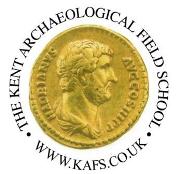 |
|
Dear Reader, we will be emailing a Newsletter each year to keep you up to date with news and views on what is planned at the Kent Archaeological Field School for the following year and what is happening on the larger stage of archaeology both in this country and abroad. To become a member or subscribe to the free newsletter go to the home page of
www.kafs.co.uk and click where it says ‘Click Here’.
I hope you enjoy! Paul Wilkinson.
|
Christmas 20AD and 2020 AD!

It was a public holiday celebrated around December 25th in the family home. A time for feasting, goodwill, generosity to the poor, the exchange of gifts and the decoration of trees. But it wasn’t Christmas. This was Saturnalia, the pagan Roman winter solstice festival.
But was Christmas, Western Christianity’s most popular festival, derived from the pagan festival of Saturnalia?
The first-century AD poet Gaius Valerius Catullus described Saturnalia as ‘the best of times’: dress codes were relaxed, small gifts such as dolls, candles and caged birds were exchanged.
Saturnalia saw the inversion of social roles. The wealthy were expected to pay the month’s rent for those who couldn’t afford it, masters and slaves to swap clothes. Family households threw dice to determine who would become the temporary Saturnalian monarch.
The poet Lucian (AD 120-180) has the Roman god Saturn say in his poem, Saturnalia:
‘During my week the serious is barred: no business allowed. Drinking and being drunk, noise and games of dice, appointing of kings and feasting of slaves, singing naked, clapping.................an occasional ducking of corked faces in icy water- such are the functions over which I preside’.
Saturnalia grew in duration and moved to progressively later dates under the Roman period. During the reign of the Emperor Augustus (63 BC-AD 14), it was a two-day affair starting on December 17th. By the time Lucian described the festivities, it was a seven-day event. Changes to the Roman calendar moved the climax of Saturnalia to December 25th, around the time of the date of the winter solstice and our Christian Christmas!
BACK TO MENU
The KAFS year was curtailed by the pandemic but we look forward to 2021 -
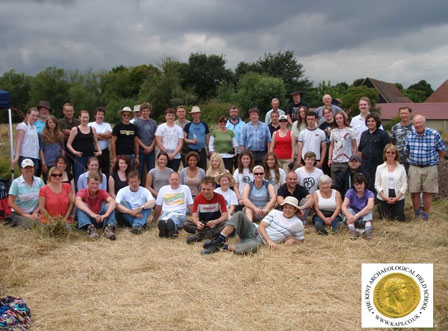
Answers on a postcard!
What year did this Abbey Fields dig take place?
Winner can enjoy a free course in 2021 at the Kent Archaeological Field School
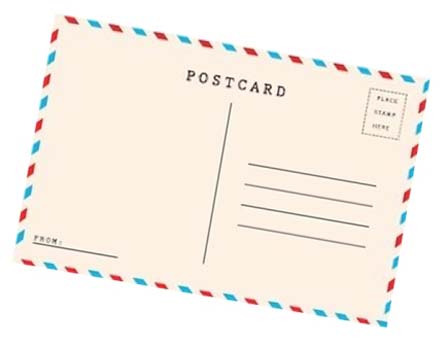
BACK TO MENU
Divided views on the Stonehenge tunnel
Letter published in the Times in October 2020:
Sir, Tom Holland (letter, Sep 13) notes that archaeologists have found ancient remains across the Stonehenge world heritage site, and implies that a road tunnel would threaten more. He is correct, hut this is a red herring. Any works dose to Stonehenge must be preceded by an archaeological survey. In the latest announcement the proposed route has been adjusted to avoid newly discovered sites. It is inevitable, however, that not everything can be saved in this way, and then excavation must occur. Remains will be disturbed, scientific studies will be conducted and finds will go to the local museum.
We will learn more about Stonehenge. The process — turning loss into enlightenment is exactly the same for all excavations, including those that have impressed Holland.
All archaeological excavation is both destructive and creative.
If there is a problem, it is that the two excavating sides — one led by pure inquiry, one by development —do not talk to each other enough. In the years ahead, it is vital that all organisations work together for the benefit of Stonehenge and the public.
MIKE PITTS Editor, British Archaeology
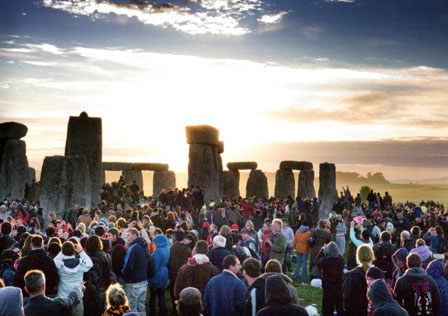
BACK TO MENU
Geophysics Resistivity Surveys at Wye in Kent
Three resistivity surveys in March 2019, September and October 2020 at a site near Wye in Kent by members of KAFS have uncovered evidence of significant Roman buildings including the possible site of a Roman mill (Photo 1). The image below shows an overlay of the three surveys in grey scale, dark is higher resistivity, light is lower resistivity. Darker areas of higher resistivity are often the result of stone, brick, and other dense building materials in walls and footings. The dark areas in the south-east corner were excavated in 2018, 2019 by KAFS and proved to be a Roman era building thought to be the watermill (red circle). All of the surveys were aligned on the NE/SW axis of the mill to make it easier to interpret the data.
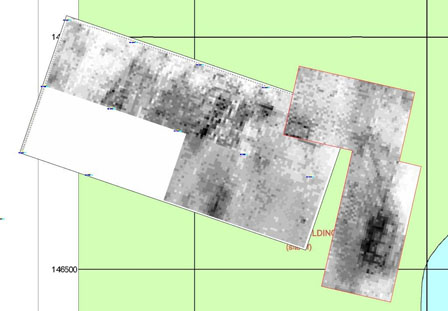
The two later surveys are consolidated in the central area of the field. The rectangular pattern at the eastern edge of the overlay is probably an outbuilding or substantial enclosure of dimensions 5x10m. There may be other faint, much larger rectangular features around this possible enclosure. To the west is a dense range of features which are likely the remains of a significant building although much disturbed by deep ploughing. These may in part be the remains of a building partly excavated in 1960 containing a hypocaust floor. This building may extend over an area 20x20m. Continuing to the North and West there is more evidence of linear features on the same alignment as the mill and these could be a further range of buildings. A previous magnetometry survey of the field showed some features at the NW edge but there are only faint signs in the resistivity.
Finally there is an intriguing NE/SW linear feature at the edge of the overlay which seems to point to further demolished structures to the South on the same alignment as the mill and might be connected to the central features. All in all this is a very exciting site and promises even more interesting results when we can survey more of the area to the South with the farmer’s cooperation. Resistivity is highly revealing of buildings and buried structures but is hard work and frankly boring on large sites such as this. The KAFS members who participated in the three surveys in the cold and wind and rain will no doubt be rewarded in a future life. They were Rebecca Parr, Stewart Brown, Zoe Schofield, and Beatrice Nicholas.
Professor Bill Martin
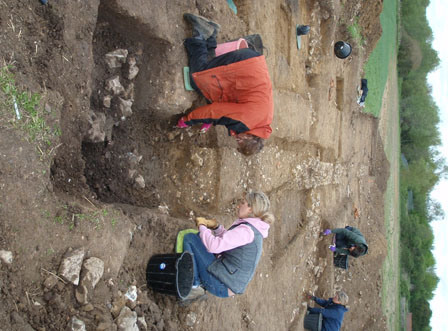
Photo 1. Possible Roman watermill (looking North)
BACK TO MENU
Christmas Gold! Sold for £80,040 to an unnamed buyer…
A metal detectorist dug the coin up in a field near Newbury, Berkshire only 20 miles away from Silchester – then Calleva where it was minted 2000 years ago. Dr John Sills author of ‘Divided Kingdoms: The Iron Age Gold Coinage of England’ said that the Caratacus gold stater is the most important single coin ever found in this country, the only known gold coin of one of Britain’s resistance leaders. Dr Philip de Jersey, former Keeper of the Celtic Coin Index said the find was ‘extraordinary’.
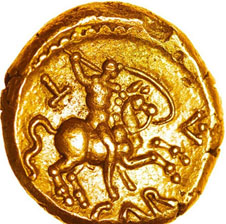
David Mitchell writing in the Times last week:
The sale last week of a gold coin issued by Caratacus, the ancient British warrior who unsuccessfully resisted the Roman invasion, has got me thinking about the branding of doomed British regimes. The coin fetched £80,040 and depicts a naked Caratacus on a horse (also naked). That sounded a bit grim to me. The emperor Claudius, Caratacus's ultimate vanquisher, never went tackle-out on the currency.
Caratacus's nudey display seems a bit try-hard, a bit Vladimir Putin, although even he tends to keep his trousers on. To be fair, the image is more tasteful than the description makes it sound - you can't really see Caratacus's bottom or penis, though there is, to my eye at least, a suggestion of horse cock. But is this the product of restraint or merely the limitations of late Iron Age minting technology? Who knows what oiled and rippling hairy balled vulgarity Caratacus might have commissioned if he'd had access to full-colour 3D printing? So it was probably for the best that this exhibitionist warrior culture was soon to benefit from the restraining influence of a vast pan-European bureaucracy.
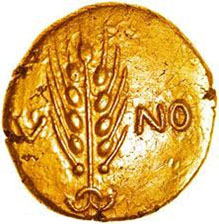
BACK TO MENU
Spectacular finds from Pompeii: Ruben Montoya writing in the National Geographic:
Since its discovery several centuries ago, few archaeological sites have fascinated the world as has the ancient Roman city of Pompeii. After the first major excavations in more than 50 years, Pompeii is revealing a surprising abundance of buried treasures. The new finds are coming from intensive work in a small sector known as Region V that has nevertheless yielded giant insights into the final days of the doomed city.
Along with the complete excavation of two houses—the House of the Garden and the House of Orion—the dig has yielded frescoes, murals, and mosaics of mythological figures in gorgeous colours, skeletons with stories still to be unravelled, coins, amulets, and show horses in the stable of a wealthy landowner.
The new finds are also sparking debate about Pompeii’s tragic story. Just before Vesuvius erupted in A.D. 79 and buried the city under a mantle of ash and rock, a local worker scrawled an inscription on a wall. Along with a joke (roughly translated as “he ate too much”), he wrote the date: October 17. The discovery of this inscription may confirm the view that the eruption took place in October, and not August, as some scholars maintain.
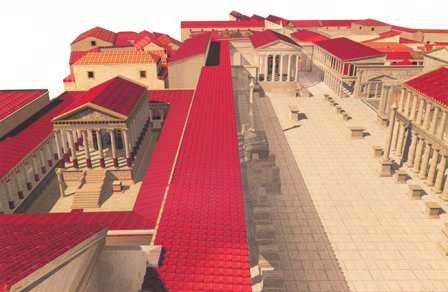
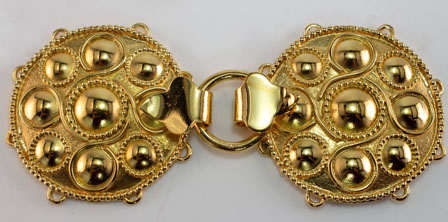
BACK TO MENU
Christmas Gifts/and something for the home-
Everything from Roman pottery oil lamps- that do work to mosaic floors and all can be found at Roman Pottery - Terra Sigillata Collection
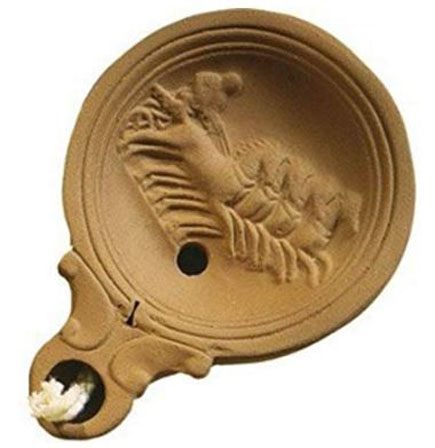
Stuck for a Christmas Gift – then try www.danegeld.co.uk who make accurate historic jewellery and include Celtic to Early Roman to Victorian to Art Deco at affordable prices...
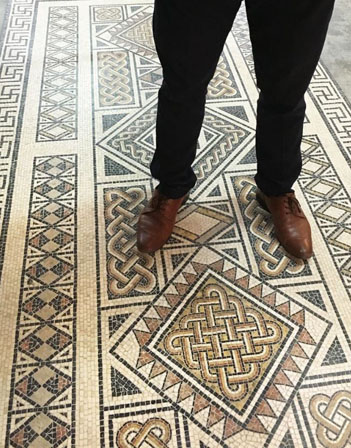
BACK TO MENU
Archaeological Guide to Pompeii.
|
Rating: 5 stars
|
|
 |
Author Paul Wilkinson and published by Taurus Books 1st Edition and Bloomsbury 2nd 3rd & 4th Editions.
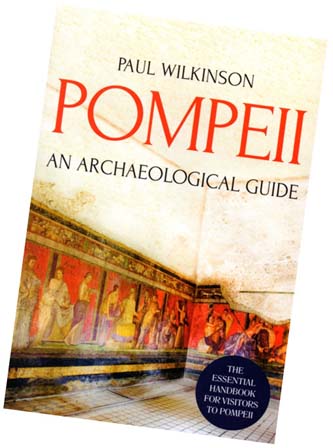
Pompeian pilgrims will be in good hands with Paul Wilkinson, an old Pompeian hand, archæologist, journalist, tour-leader and BBC documentary maker.
The index is serviceable, though somewhat choosy on no obvious principle, especially regarding the names of modern scholars. After a tersely helpful Timeline from antiquity to
AD 1997, the Introduction and trio of chapters survey everyday life in Pompeii, plus detailed descriptions of the Amphitheatre Riot of AD 59 and the eruption itself, with full transcriptions of Pliny the Younger’s pair of autoptic accounts. These pages display how well Wilkinson knows his Pompeian onions.
This book stands or falls with the archæological sites-guide that makes up its second part.
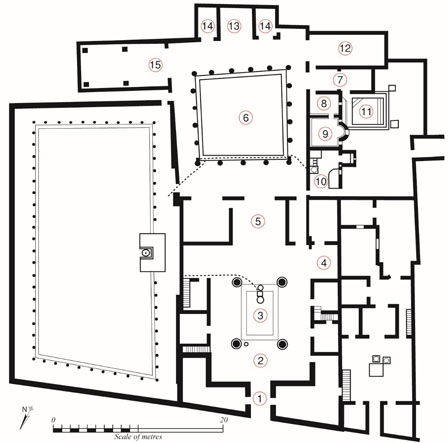
Here, Wilkinson is faultless. His diagrams are clear, the relevant information dispensed without fuss, with due acknowledgement to the many archæologists and epigraphers involved. All this written in clear, jargon-free English, nicely leavened with wit.
The Romans had Pompey the Great. In Wilkinson, we have a Great Pompeian.
Professor Barry Baldwin
BACK TO MENU
Underland a deep time journey.
|
Rating: 5 stars
|
|
 |
Author Robert Macfarlane
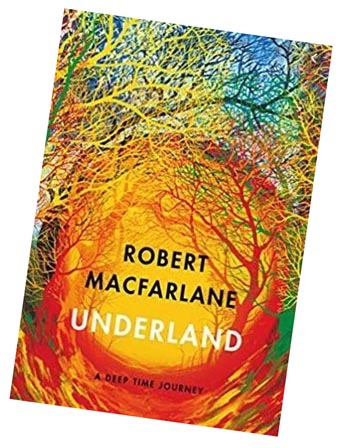
Underland is, as its title suggests, “a book about burial and unburial and deep time”, “the awful darkness inside the world”, “of descents made in search of knowledge”, to study the places where “we have long placed that which we fear and wish to lose, and that which we love and wish to save”. If fear is a constant companion on such journeys, for the reader at home there are many pleasures, most notably the armchair exploration of a far more benign landscape: the interior of Macfarlane’s magnificently well-furnished mind. For the darkly tangled path this book takes through the labyrinth of history and memory, literature and landscape, high-flown prose and underworldly observation are illuminated by Macfarlane’s inventive way with language. At its best, this has an epic, incantatory quality. There is a rare gift at work here: chiselled prose of such beauty that it can, on occasion, illuminate the darkness below ground as startlingly as a Verey light sent up into the vaults of one of Macfarlane’s subterranean stalactite cathedrals.
Like WG Sebald, another teacher of literature, Macfarlane brings the full weight of his erudition to the table. He quotes a dazzling range of poets and novelists and great galaxies of writers on geology, archaeology, mythology, morphology and glaciology, as well as on nuclear science, “dark matter” physics and art history. We swing from the thoughts of Rainer Maria Rilke on the Orpheus myth to the latest discoveries about “hyphae” – “the superfine threads fungi send out through the soil” – then move from learned opinions on Neanderthal rock art dating from around 65,000BC to Sir Thomas Browne (a particularly Sebaldian moment) to HG Wells, Jorge Luis Borges, Italo Calvino and Cormac McCarthy.
Underland is, unquestionably, his magnum opus, a work that has taken him nearly 10 years to complete. Though darker than his earlier books, it is as rich as anything he has ever written, blessed with the scholarship of Sebald, the stylistic felicity of Bruce Chatwin and the vocabulary and syntax of Patrick Leigh Fermor. It contains the summation of his most important ideas. Nearly 40 years ago, the critic Paul Fussell wrote that with The Road to Oxiana, Robert Byron had done for the travel book what James Joyce did for the novel with Ulysses. This is the flame that Macfarlane has now carried into a new century.
With Underland he has written one of the most ambitious works of narrative non-fiction of our age, a new Road to Oxiana for the dwindling twilight of the Anthropocene.
• Underland by Robert Macfarlane is published by Hamish Hamilton (£14)
BACK TO MENU
Mudlarking: Lost and found on the River Thames.
|
Rating: 5 stars
|
|
 |
Author: Lara Maiklem
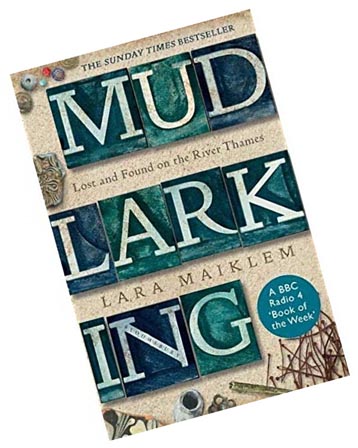
Francis Wilson of the Guardian writes: Mudlarks are
river scavengers, but Lara Maiklem is more like a
time traveller. Using old maps as guides to London’s
former boatyards, quaysides, bridges, causeways,
jetties and great houses – all those places where the
rubbish was once dumped – she scours the foreshore
of the Thames looking for links to another life:
Roman brooches, clay pipes, Victorian shoe buckles,
Mesolithic flints. A vast and mobile archaeological
site, the Thames is uniquely suited to mudlarks
because it is tidal, which means that every day,
as Maiklem explains, it grants access to its contents,
“which shift and change as the water ebbs and flows, to reveal the story of a city, its people and their
relationship with a natural force”.
Every drowned, unwanted or lost object is precious to Maiklem, who reveals, as she takes us downriver
from Richmond to the Estuary, a preternatural sympathy for the broken, mud-caked and out of context.
When, during one of her daybreak larking stints, she finds a body, “arms outstretched, her long hair spread
out like a soft halo”, she feels not horror but fellowship: “I was the first to be with her after her final and
most private moment.” A custodian of the past, Maiklem’s relation to the life of the river is personal rather
than scientific. She sees the Thames as the home of her forebears and the medium of their messages. Alert
to the ethics of ownership, she collects only those treasures that the museums reject, but engraved
wedding rings are thrown back into the water: Maiklem does not want their sadness in her life.
Time was when mudlarking was the reserve of the destitute, but these days a mudlark permit is needed,
for which you have to belong to the Society of Mudlarks (founded in the 1970s), and to be eligible to join
the society you need to have already held a standard permit and reported your findings to the Museum of
London for two years. Even then, you may not be given membership because the society “maintains a
deliberate air of mystery and exclusivity”.
Maiklem divides mudlarks into hunters and gatherers. Hunters – usually men – are goal orientated and
tend to employ metal detectors; the shoreline is “a battlefield” of “petty feuding, territorial disputes,
jealousies, fierce competition and paranoia”. For gatherers, usually women, the search is as important as
the find: mudlarking is meditation
• Mudlarking: Lost and Found on the River Thames is published by Bloomsbury (£18.99). To order a copy of
all books go to
guardianbookshop.com or call 0330 333 6846. Free UK p&p over £15, online orders only.
Phone orders min p&p of £1.99.
BACK TO MENU

We will be back in Oplontis in the first three weeks in July 2021 for another season of excavation but watch this space and do not book flights or hotels until both the pandemic and Brexit are sorted. The only criteria for booking is that you are a member of the Kent Archaeological Field School www.kafs.co.uk www.kafs.co.uk and that you have some experience or enthusiasm for Roman archaeology, Italian food and Italian sunshine! See also the website for the project at www.oplontisproject.org. . Please note food, accommodation, insurance, and travel are not provided and to cover casts we will be charging £10 a day per person.
Flights to Naples are probably cheapest with EasyJet. To get to Pompeii take a bus from the Naples airport to the railway station and then the local train to Pompeii. Hotels are about 50eu for a room per night.
We are staying at are the Motel Villa dei Misteri and the Hotel degli Amici. [email protected] [email protected] For camping the site Camping Zeus is next to the hotel: [email protected] and is about 12eu a night.
Transport to Oplontis from Pompeii is not provided but most of the group use the local train (one stop). Please note it can be hot so bring sun cream and insect repellent! Any queries email me at [email protected] or in Naples call my mobile on 07885 700 112. We will meet up at 8am every Monday morning of the dig at Motel Villa dei Misteri to start the new week.
Paul Wilkinson
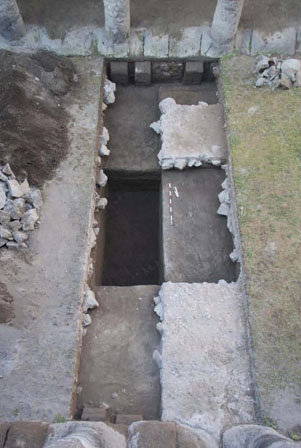
BACK TO MENU
Courses at the Kent Archaeological Field School for 2021 will include:
Field Walking and Map Analysis Easter 2021 –
Good Friday 2nd April to Easter Monday 5th April.
Field work at its most basic involves walking across the landscape recording features seen on the ground. On this weekend course we are concerned with recognising and recording artefacts found within the plough soil. These include flint tools, Roman building material, pottery, glass and metal artefacts. One of the uses of field walking is to build up a database for large-scale regional archaeological surveys. We will consider the importance of regressive map analysis as part of this procedure. The course will cover:
1. Strategies and procedures,
2. Standard and non-standard line walking, grid walking,
3. Pottery distribution, identifying pottery and building ceramics.
We will be in the field in the afternoons so suitable clothing will be necessary.
Cost £10 if membership is taken out at the time of booking.
For non-members the cost will be £25.
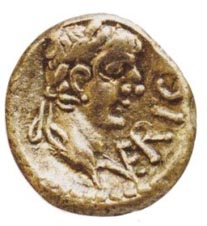
Wye Roman Villa and Water mill: Spring Bank Holiday Monday 31st May for five days and the Summer Bank Holiday Monday 30th August 2021 for five days
Archaeological excavation on the site of a recently discovered Roman Villa and water mill at Wye in Kent (see main article). A very exciting venture beside the River Stour to the south-west of Wye. Geophysical survey has revealed a multitude of features and recent field walking and excavation by KAFS students has identified a probable Roman water mill alongside an artificial leat (see below red arrow). The field walking identified areas of Roman building material and pottery which path founded the successful programme of geophysical survey.
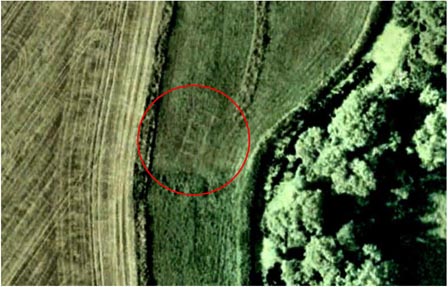
The Summer Bank Holiday Week will also host the annual KAFS Training Week. We shall look at the ways in which archaeological sites are discovered and excavated and how different types of finds are studied to reveal the lives of former peoples. Subjects discussed will include aerial photography, regressive map analysis, HER data, and artefact identification.
The five day course runs from Monday 30th August to Friday 3rd September 2021 and will be especially useful for those new to archaeology, as well as those considering studying the subject further. This will be held either on site at the Faversham base or on-site at Wye. After the morning tea break we will participate in an archaeological investigation on a Roman building at Wye under expert tuition. Expert diggers are not required to participate in the tool box talks.
Cost £100 per person.
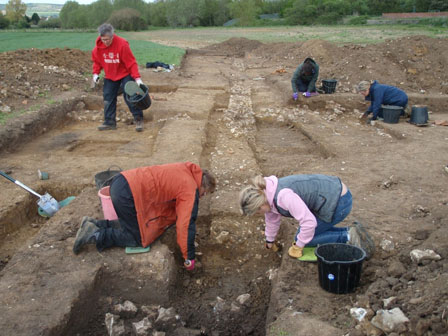
Saturday September 18th to Monday 20th 2021. Investigation of Prehistoric features at Hollingbourne in Kent
An opportunity to participate in excavating and recording prehistoric features in the landscape. The long weekend is to be spent in excavating prehistoric features located with aerial photography and geophysical survey. In addition there will be a one day flint knapping course by one of Britain’s leading specialists.
Cost £50 per person.
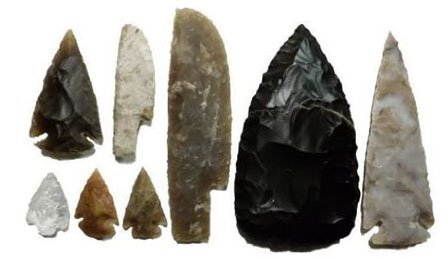
Happy Christmas from all at KAFS!
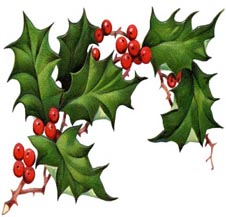

For all booking enquiries email
[email protected]
The Kent Archaeological Field School.
The Office, School Farm Oast,
Graveney Road, Faversham, Kent ME13 8UP
Tel: 01795 532548 Email:
[email protected]
Director Dr Paul Wilkinson FRSA MCIfA
KAFS BOOKING FORM
You can download the KAFS booking form for all of our forthcoming courses directly from our website, or
by clicking here
KAFS MEMBERSHIP FORM
You can download the KAFS membership form directly from our website, or
by clicking here
BACK TO MENU































